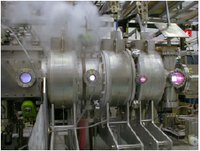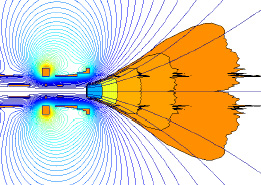Variable specific impulse magnetoplasma rocket
|
|
The Variable specific impulse magnetoplasma rocket (VASIMR) is a hypothetical form of spacecraft propulsion that uses radio waves and magnetic fields to accelerate a propellant. VASIMRs are intended to bridge the gap between high-thrust, low-specific impulse propulsion systems and low-thrust, high-specific impulse systems, as they are capable of functioning in either mode simply by adjusting their parameters of operation.
Current VASIMR designs should be capable of producing specific impulses ranging from 10,000-300,000 m/s (1,000-30,000 seconds) - the low end of this range is comparable to some ion thruster designs. Even if relatively high thrusts become available, VASIMR drives are expected to require a great deal of heavy machinery to confine even relatively diffuse plasmas, so they will be unusable for very-high-thrust applications such as launch from planetary surfaces.
The propellant, usually hydrogen, is first ionized by radio waves and then is guided into a central chamber threaded with magnetic fields. The ions spiral around the magnetic field lines with a certain natural frequency; by bombarding them with radio waves of the same frequency, the system heats the ions to 10 megakelvins. A magnetic nozzle converts the spiralling motion into axial motion, driving the hydrogen ions out the back of the rocket and producing thrust.
The radio waves and magnetic fields would be produced by electricity, which would most likely be produced by nuclear fission. Any conceivable chemical fuel used in a fuel cell or to activate a generator would be more efficiently used in a conventional rocket. Solar energy might be more efficiently used in a solar thermal rocket, which would have lower specific impulse but higher energy efficiency.
By adjusting the manner of heating and a magnetic choke, a VASIMR can control the exhaust rate. Closing the choke shifts the rocket into high gear; it reduces the number of ions exiting the drive (thus producing less thrust), but keeps their temperature high (thus increasing specific impulse). Opening the choke has the reverse effect. A spacecraft would use low gear to climb out of planetary orbit, and high gear for interplanetary cruise.
The method of heating plasma used in VASIMR was originally developed as a result of research into nuclear fusion. One possible future enhancement of the VASIMR system may be to promote fusion among the atoms of the propellant; this could provide a great deal of extra heating, and therefore provide even greater thrust than the electrical input into the system would otherwise allow. However, such an enhancement is not expected to be practical in the near future.
External links
- NASA: Propulsion systems of the Future (http://www.nasa.gov/vision/space/travelinginspace/future_propulsion.html)
- NASA HSF- VASIMR (http://spaceflight.nasa.gov/shuttle/support/researching/aspl/vasimr.html)
- NASA Tech Brief: VASIMR (http://www.nasatech.com/Briefs/Sep01/MSC23041.html)
- Rapid Mars Transits with Exhaust-Modulated Plasma Propulsion (PDF) (http://ston.jsc.nasa.gov/collections/TRS/_techrep/TP-1995-3539.pdf)


